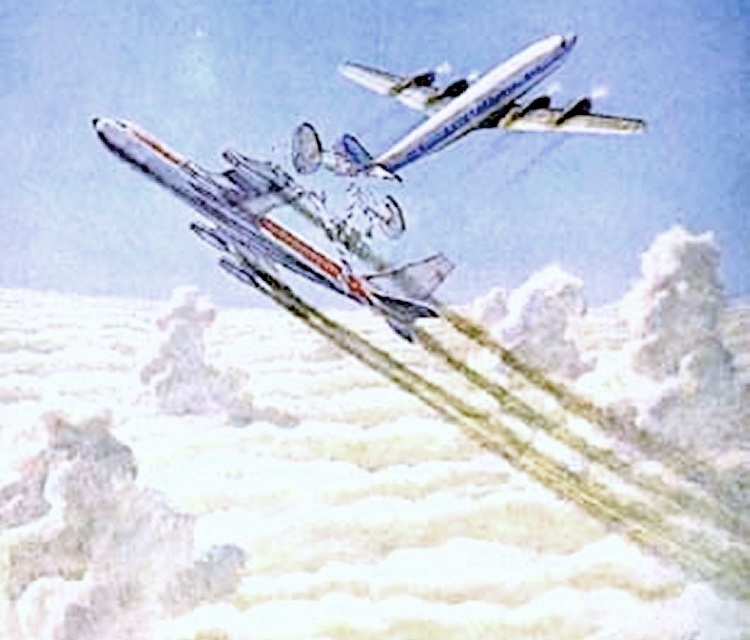
Two passenger airliners collided at North Salem, NY, on Sat, 4th December 1965.
One aircraft was N6218C, a 1953 Lockheed L.1049C Super Constellation c/n: 4526, flying Eastern Air Lines flight 853 en route from Boston Logan Int'l Airport to Newark Int'l Airport.
The other aircraft was N748TW, a 1962 Boeing 707-131B c/n: 18387/286, flying TWA flight 42 en route from San Francisco Int'l Airport to John F. Kennedy Int'l Airport.
The collision occured over Carmel, New York.

TWA Flight 42 made an emergency landing at JFK.
Captain Charles J. White of the Eastern Air Lines flight 853 manoevred a miraculous crash landing on Hunt Mountain near Danbury, Connecticut. The Super Connie had 54 on board. Three passengers died, plus Capt. White, who had returned to the aircraft's cabin to help the last passenger.
This was covered in an article, Ten Minutes To Live, by Warren R. Young in Readers Digest May 1967 issue, p. 198.
I read this article at my uncle's place at D-17, 74 Bungalows, Bhopal in the summer of 1968, where I was on summer vacation between 5th and 6th standards.

On Sat, 4th December 1965 the weather over northeastern New York was in a post frontal zone with a frontal system extending into the Atlantic Ocean
from a low pressure area centered 100 to 150 miles of the Massachusetts coast.
The weather over White Plains, New York was 4,000 ft. scattered clouds, 8,000 ft. broken clouds, 12 miles visibility, temperature 46° F, dew point 35° F, wind from 300° at 7 knots.
The weather over the Carmel VORTAC at 16:19 est. called for variable cloud conditions with the tops at or near 8,000 ft. and isolated tops up to 13,000 ft. There was also a broad area of scattered rain showers in the area.
After climbing out of Syracuse a corporate pilot reported the weather as, through multi-layered clouds after his departure from Syracuse, and was on top of an overcast at 15,000 ft., approx. 25 miles southeast of Syracuse. He described the overcast as continuous and relatively smooth with some billowing in the Carmel area.
At 16:45, approximately 30 minutes after the accident, he descended in the area of the Camel VORTAC and reported that he was just clear of the tops of the clouds at 11,000 ft. and in the clouds at 10,000 ft. He also reported the visibility was unrestricted above the overcast.
At 09:05 PST (TWA) Trans World Airlines Flight 42 departed San Francisco International Airport, California on an IFR flight plan to John F. Kennedy Airport, New York.
TWA 42 was a red and white Boeing 707-131B tail number N748TW.
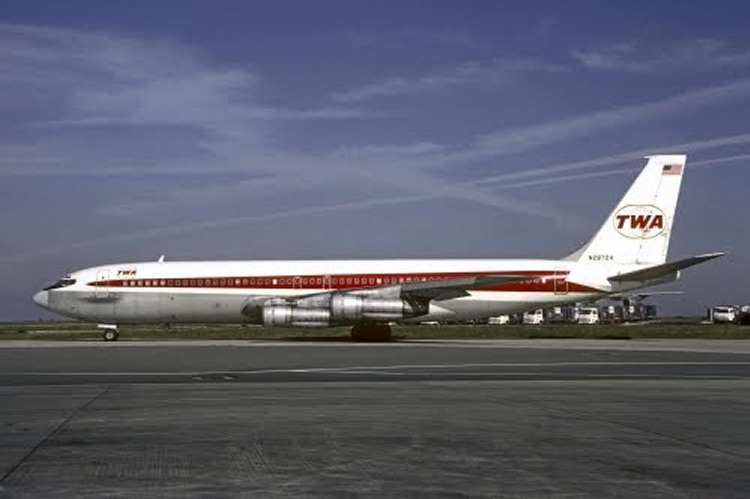
At the time of departure in San Francisco TW 42 had a take off gross weight of 222, 174 lbs. On board the aircraft was 82,000 lbs of fuel.
The flight was routed via Sacramento, California, Reno, Nevada, Sioux Falls, South Dakota, and Buffalo, New York, at various altitudes.
At Buffalo, the log indicated the flight was at flight level (FL) 370 at 15:48. Subsequently, the flight descended to FL 250 under the control of the New York Air Route Traffic Control Center (ARTCC). TW 42 was then cleared to descend to FL 210 and later to 11,000 feet msl, and was given the JFK altimeter setting of 29.63.
The flight reported level at 11,000 feet. During the entire flight there were no maintenance discrepancies logged in the log book for the flight.
TW 42 was cruising in clear air as it approached the Carmel VORTAC at a groundspeed of 355 knots on a track of 128°. They were flying above the overcast with no restrictions in visibility. The aircraft was flying on auto pilot with the altitude hold feature engaged. Captain Carroll had his left hand on the control yoke.
The flight crew of TW 42 was a very experienced crew with a perfect safety record.
In command of TW 42 was Captain Thomas H. Carroll of TW 42, age 45, was employed by Trans World Airlines on September 24, 1945, and was promoted to captain on Nay 28, 1956. He had a total of 18,842 flying hours, 1,867 of which were in Boeing 707 aircraft. He held valid FAA airline transport pilot certificate which included a type rating in Boeing 707 aircraft. His last proficiency and line checks in the Boeing 707 aircraft were on September 7, 1965, and October 17, 1965, respectively. His last first-class medical certificate was dated September 22, 1965, with no limitations.
His First Officer was Leo M. Smith, age 42, was employed by Trans World Airlines on November 2, 1953, and was promoted to first officer on December 30, 1953. He had a total of 12,248 flying hours, 2,607 of which were in Boeing 707 aircraft. He held valid FAA airline transport pilot certificate. His last proficiency check in Boeing 707 aircraft was June 25, 1965. His last first-class medical certificate was dated September 10, 1965, with no limitations.
Along with Flight Engineer Ernest V. Hall age 41, he was employed by Trans World Airlines on August 8, 1947, and was promoted to flight engineer on July 19, 1951. He had a total of 11,717 flying hours, 5:52 of which were in the Boeing 707 aircraft. He held valid FAA flight engineer certificate and commercial pilot certificate.. His last proficiency and line checks in the Boeing 707 aircraft were on November 24, 1965, and December 1, 1965, respectively. His last second-class medical certificate was dated February 17, 1965, with a waiver that "holder shall possess correcting glasses for near vision while exercising privileges of his airman certificate.
Looking out of his window Captain Carroll observed a blue and white aircraft at his 10 o’clock position in what he assumed was on a collision course with his aircraft. He immediately disengaged the auto pilot by actuating a switch on the yoke with his left thumb, put the wheel hard over to the right and pulled back on the yoke. At the same time first officer Smith grabbed the yoke and followed through with the Captain’s movement of the yoke. As the big 7070 rolled to the right it became evident to the crew that they were not going to avoid a collision, the crew immediately reversed the direction of the yoke to the left. Before the aircraft had a chance to react to the control reversal, two shocks were felt and the big jet entered a steep dive. The crew regained control and began emergency assessment of the problem.
As TW 42 passed under and toward the rear of Eastern Flight 853 the No. 1 cowling and a portion of the left wing of the 707 struck the underside of the main fuselage of the Constellation. The collision tore out the hydraulic boost package and the control cables to the rear empennage of EA 853, rendering the elevator and rudder flight controls inoperative. Contacting New York ARTCC TW 42 immediately declared an emergency and informed them that their left wing tip was missing. New York ATC issued vectors and a descent clearance to JFK airport.
After arriving southeast of JFK airport they began flying a large 360° left turn in order to ascertain that the landing gear was fully down and locked. TW 42 landed safely at on runway 31L at approximately 1640.
TW 42 showed primary impact damage in three areas:
The big Blue and White striped Eastern Airlines Lockheed, 1049C Constellation designated as Flight 853 a normally scheduled shuttle flight departed Boston, Logan Airport for a flight to Newark, New Jersey.
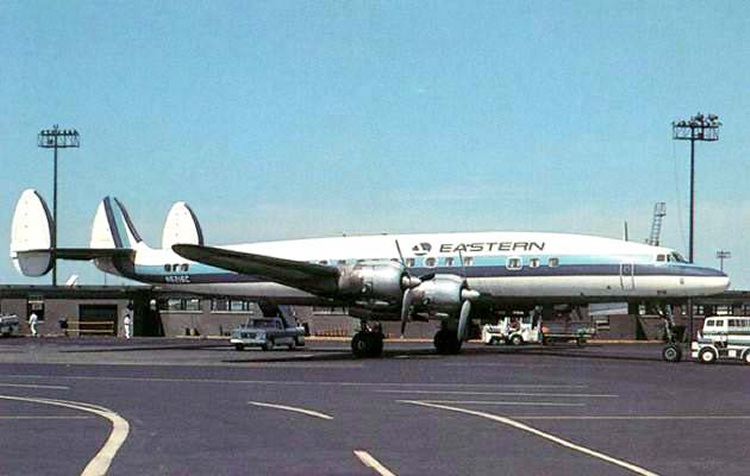
At the time of takeoff the Connie had an operating weight of 97, 019 lbs well below the maximum allowable Gross Takeoff Weight of 113,075 lbs. The flight climbed to 10,000 ft. and went into cruise. ATC control at Boston handed off the flight to New York ARTCC at 16:10 EST. At 16:18 EST, New York ATC recorded on the flight strip for EA 853 that the aircraft was passing Carmel VORTAC. The flight plan called for EA 853 to fly southwest out of Boston, direct to the Carmel VORTAC, where they would be given descent clearance for vectors into Newark, Airport.
As Eastern Flight 853 approached Carmel VORTAC on a track of 252° and a ground speed of 213 knots, the connie was in level flight at 10,000 ft indicated, flying in and out of the tops of a “fluffy” cloud deck with the tops of the clouds about 300 feet above their level. They were cruising along with an airspeed of 205 to 210 KIAS (Knots Indicated Air Speed). They were flying into the sun but the crew needed neither sunglasses nor use of their glare shield.
At 15:38 EST, Captain Charles J. White age 42, who was employed by Eastern Air Lines since October 26, 1953, had a total of 11,508 flying hours of which 1,947 were in L-l049 aircraft.
He held valid air transport pilot certificate with a type rating in L-1049 aircraft.
His last proficiency check and line check as on November 8, 1965, and November 5, 1965, respectively.
His last first-class medical examination was dated October 25, 1965, with no waivers.
His First officer was Roger I. Holt, Jr., of EA853, age 34, was employed by Eastern Air Lines on February 5, 1962. He had a total of 8,090 flying hours, 899 of which were in L-1049 aircraft. He had 241 hours in L-1049 aircraft as flight engineer. He held valid FAA commercial pilot certificate No. 1095281 with appropriate ratings, and FAA flight engineer certificate No. 1542827. He also held a valid free balloon pilot rating. His last proficiency check was dated September 14, 1965. His last first-class medical examination was dated March 9,1965, with no waivers.
The Second officer was flight engineer Emile P. Greenway, age 27, was employed by Eastern on January 27th, 1964. He had a total of 1,011 flying hours of which 726 were in the L-1049. He held a valid commercial pilot certificate and flight engineer certificate, his last check ride was dated July 17, 1965.
Just as EA853 emerged from a cloud puff First Officer Holt observed a jet aircraft from his right side window he estimated to be at his 2 o’clock position. The aircraft appeared to be converging at the same altitude as EA853.
Holt immediately exclaimed “Lookout”, and placed his hands on the control yoke and made a very rapid application of up elevator simultaneously with Captain White.
The pull up was so severe that the crew was pulled into their seats by the G force.
Just as impact occurred EA853 continued to climb.
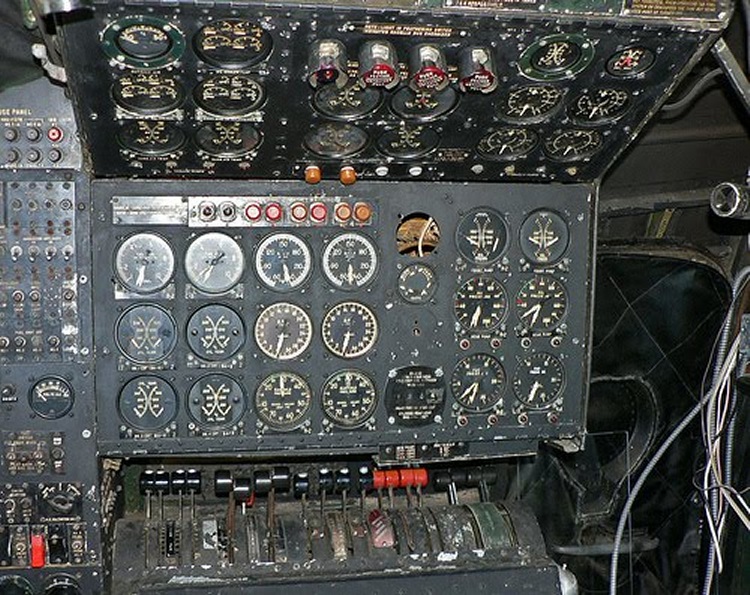
Flight Engineer Greenway facing the engineer’s panel saw four red lights flash on, the planes hydraulic pressure had dropped, indicating that they were losing hydraulic pressure.
Engineer Greenway called out “Pressure and quantity! Pressure and quantity!
Captain White reached out and pulled the hydraulic boost levers, the link between the control column and the control surfaces on the wing and tail.
Normally the aircraft could be flown via the fixed control cables, but they also were severed and failed to respond to the flight crew’s inputs.
The aircraft shuddered and then began a diving left turn. The airspeed at times went above the normal operating speed.
Two minutes after the collision engineer Greenway called New York ATC on the radio,
“Mayday!” “Mayday!” “Mayday!” This is Eastern 853, we have had a mid air collision and are …Ah … in trouble.
We’re out of control. We’re in dive now, climbing now, we’re descending, we’re at, ah 7,000 feet.”
At 16:24 Greenway was back on the radio advising New York on the situation, New York was giving Eastern 853 heading , when Captain White responded, “We’ll just do the best we can, keep an eye on us, please, and see we’re gonna wind up”. While diving the crew could not regain control of the aircraft, there was no response from the controls or trim tabs.
The only way they regained control was with power applications of the throttles.
The aircraft began to zoom up and down several times into the clouds.
Finally after expert maneuvering of the throttles a setting was found which would maintain a descent and level attitude with some degree of consistency.
Passing over the Danbury airport at 2,000 to 3,000 feet, which was too high for them to make an approach.
They could only maintain airspeed of between 125 and 140 knots, the whole time. The aircraft's nose would rise when power was applied and fall off when power was removed. Their rate of descent was maintained at approximately 500 ft/min. The aircraft was continually circling to the left, by manipulating the throttles and causing the engines on the left wing to run faster than those on the right, this helped maintain a steady altitude and slowly stop the aircraft from continually turning to the left.
Amongst all the stress and dealing with the emergency Captain White was also able to make an announcement to the 49 passengers.
Captain White and the crew new it was apparent that the flight could not be maintained and a decision was made to effect a landing in an open field.
Looking out of the cockpit windows Captain White and First Officer Holt discussed the situation, they had three options,
“I don’t much care for the lake,” Holt said. “I don’t think very many would get out alive”. The crew could see the steep hill and were deeply concerned about the hazard of trying to put the aircraft down there. Captain White spotted a small pasture on the side of the hill called Hunts Mountain, when he looked over at his co-pilot and said “how about that field?” Holt replied, “Lets do it.”
As the light was fading on this late afternoon December day, Captain White scanned the area, making his approach while manipulating the throttles.
He spoke to the passengers one more time, “Brace yourselves. Here it comes!”
“The field was clear of animals, but three boys were walking across it. The oldest boy, Danny Williamson, yelled at his brother and their friend to jump over a stone wall edging the field. There was no time to run farther, and they crouched there as the big ship rushed right toward them.
In the field stood two houses and a large barn with a concrete silo. To use all the field for his landing Captain White had to coax his plane down almost to roof level and fly between the buildings. In the barn were 20 saddle horses, two horsewomen, a groom and 14 year old Geoffrey von Kuhn an after-school stable boy.
To make the crash resemble a landing. Captain White had to make the plane perform one more last maneuver, the most critical of all. He could see, as they closed in through the dusk, that because of the slope of the hill, they would bore nose first into the earth if nothing was done. All of his pilot training teaches him, when landing a normal plane, to pull back on the control yoke and shut down the power so the aircraft will settle gently to earth. But with no controls, Captain White would have to put the power on again to lift the nose. If he did it a second or to soon the plane would zoom up, miss the field and stall and drop in a flaming heap. If he did it a second to late, the nose would not lift in time and the plane would smash harder into the ground.
Co-pilot Holt saw the need, too, and reached out to shove the throttles, but the captain’s hand, already there, had chosen the moment. White revved all the engines to full power and at the precise instant need to tilt the nose up before impact.
“Just that final maneuver alone, sensing when to pour on the power” says Gary Holt, Roger’s brother and himself a Constellation pilot for Eastern, “has got to be called one of the most magnificent feats of airmanship in the history of flying.”
Now as the belly of the ship skimmed above the grass at the bottom end of the field, the left wing smashed into a tree about four feet above the ground. The wing tore completely off at the root. The rest of the plane slammed against the far bank of an unavoidable gully, bounced through the air and skidded thunderously up the hill. At impact there was a might explosive “Whoomp”, and a huge yellow flame shot 100 ft. skyward. 9½ min. had gone by since the collision in the air.
As the broken ship slid uphill, huge pieces ripped off and bounded up the field. All four engines broke free and hurtled after the plane.
The remaining tail section fell off. The jagged stub, where the left wing had once been, dug deep into the ground, catapulting the sliding hulk of the plane around to the left.
Under the strain the fuselage cracked like an egg shell into three pieces.
By the time it came to a stop 700 ft. up the hill, ( and about 150 ft. from the boys) it lay like a nearly closed hinge with its front and rear ends pointed roughly down the slope toward the northeast.
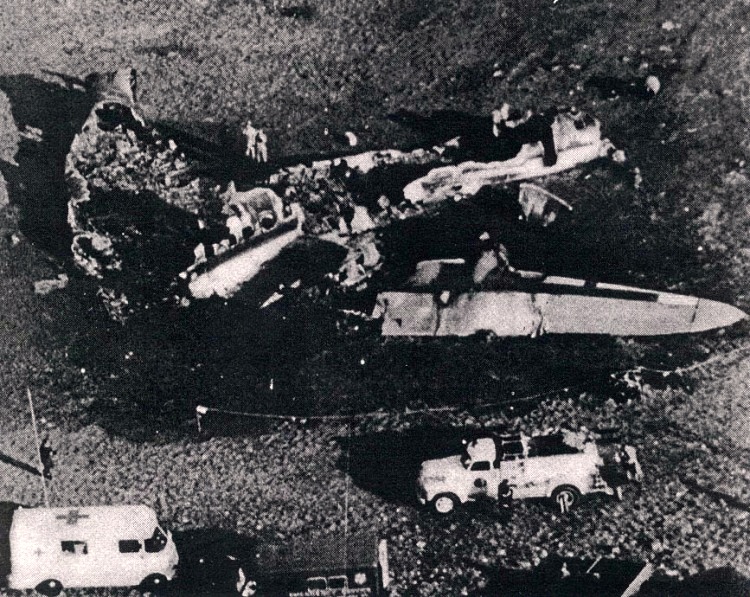
Stewardess Kathy DePue kept trying to walk down the isle to help a woman passenger out, but her efforts seemed to be turning into slow motion. Crying for help, she turned over the job of helping the woman to some men, and staggered out upon the hill, where one of the soldiers carried her to safety. She had a crushed spinal disc, that would have to be removed.
The other stewardess, Patricia Skarada, had just leapt out the broken fuselage when she heard a young mother moaning, and saw her still in the wreckage. Pat took the baby from her and led her out of the plane. Then she hurried back in to help other passengers. Later she saw Kathy DePue lying on the ground where the soldier had placed her. Pat bent over to see how badly Kathy was hurt, then found that she could not straighten up. She had five broken bones in her back.
A soldier Pvt. Dennis Flucker was in trouble. His buddies tried to help him unfasten his jammed seat belt without success. Finally the heat of the flames drove them to make their own escape.
Along with the passengers, ambulances carried away the co-pilot and flight engineer.
Emile Greenway was able to walk, and was found sitting near the stone wall with a bad gash on across his ear and head. His left hand was cut, probably by the electric switches he flicked off at the last moment. But he was in shock. His memory of all the events from the final approach onward was wiped out, and in fact he would remember nothing that happened during the next two days. Apparently he left the cockpit through a crew door beside his position.
Co-pilot Holt was more badly hurt, and his escape from the plane had been difficult. Holt crawled or fell out of the small sliding window on the left side of the cockpit, the captain’s side and then collapsed in a heap.
Neither Holt or Greenway has ever been able to recall whether he got out by himself or was helped out by the captain.
And to this day no one can say with certainty just what happened to Captain Charles White. It seems clear that, immediately after the crash, he had no serious injuries. He had brought his stricken aircraft down by means of superb talent and unshakeable nerve.
There is little doubt that Charles White could have walked out the wreckage to join the living and to enjoy the acclaim he had earned, but the rule of air travel, as at sea, that the captain is the last to leave the ship.
His younger brother, Lou, remembers the time Chuck White confided his own concept of duty, during his Air Force days. News reported a story about a bomber crash in which the pilot parachuted to safety but all the other crew men went down with the plane. “If a plane of mine ever goes down, “ Chuck said, “Even the dead men are going out on parachutes before I do.” His words were more than prophetic.
For one thing is certain: Captain White was later found, not in the cockpit but back in the passenger cabin. All the available evidence shows that, alone in the cockpit and with two open ways to get out, he faced up to his final duty. Just 9½ min. after the mid air collision, as oxygen bottles blew up and the flames and smoke billowed ever more fiercely throughout the plane, he walked back to try save the last passengers. There are faint clues that he succeeded in unfastening Private Flucker’s seat belt and then turned to lead the way out.
“In my personal opinion,” says safety investigator Jack Carroll, who arrived on the scene that night to study the accident for the CAB. “There is little doubt that Captain White had deliberately gone back to the cabin to help the young soldier.” There, perhaps 30 sec later, along with Pvt. Dennis Flucker, Capt. Chuck died, overcome by the poisonous fumes from by the fire.